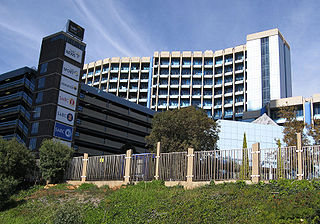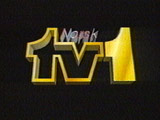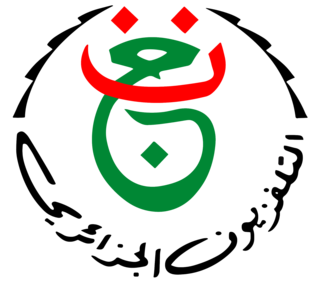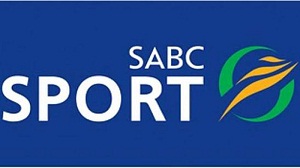
Sveriges Television AB, shortened to SVT, is the Swedish national public television broadcaster, funded by a public service tax on personal income set by the Riksdag. Prior to 2019, SVT was funded by a television licence fee payable by all owners of television sets. The Swedish public broadcasting system is largely modelled after the system used in the United Kingdom, and Sveriges Television shares many traits with its British counterpart, the BBC.

Television in South Africa was introduced in 1976. The country is notable for the late introduction of widespread television broadcasting.

The South African Broadcasting Corporation (SABC) is the public broadcaster in South Africa, and provides 19 radio stations (AM/FM) as well as six television broadcasts to the general public. It is one of the largest of South Africa's state-owned enterprises.

SVT1 is the primary television station of the Swedish public service broadcaster Sveriges Television in Sweden.

SVT2, is one of the two main television channels broadcast by Sveriges Television in Sweden.

SABC 3 is a South African free-to-air television channel owned by the South African Broadcasting Corporation (SABC). It carries programming in English and, few in other South African languages. It has a number of its own reality and talk shows and had lately introduced a new series called “The Estate”.

SABC 2 is a South African free-to-air television channel owned by the South African Broadcasting Corporation (SABC). SABC 2 broadcasts programming in English, Afrikaans, Venda, and Tsonga.
Free-to-air (FTA) services are television (TV) and radio services broadcast in unencrypted form, allowing any person with the appropriate receiving equipment to receive the signal and view or listen to the content without requiring a subscription, other ongoing cost, or one-off fee. In the traditional sense, this is carried on terrestrial radio signals and received with an antenna.

RTM TV1 is a Malaysian free-to-air public television channel owned and operated by Radio Televisyen Malaysia, a broadcasting department of the Malaysian Government. Launched on 28 December 1963, TV1 is the first and oldest TV station in Malaysia. The channel features mostly news, talk shows and documentaries and some in-house, local and international kids, drama and sports programming.

Norsk TV1 was a Norwegian television station. Norsk TV1 started in 1989. It was focused on Norwegian shows and films, and produced a lot of entertainment shows for its weekend programming. Norsk TV1 had its first test broadcasts in December 1988, but did not start with regular broadcasts until February 1989. Norsk TV1 was advertising-financed and was owned by Orkla. It was the third private Norwegian channel to be established in Norway. It was closed down in June 1989 due to financial problems and was taken over by TVNorge. TV1 had a lot of own productions, including the talk show program Wesenstund with Rolv Wesenlund, which quickly became the channel's big attraction. This program re-emerged on TVNorge in 1994.
Television began in Sweden in 1954 with test transmissions, prior to the opening of the first station, Radiotjänst, two years later. A second channel was launched in 1969. Commercial television arrived in the 1980s through cable television and in 1992, the country's first terrestrial commercial channel was launched.

Public Establishment of Television, abbreviated as EPTV, is a state-owned company that manages the activity of television in Algeria, going from production to broadcasting.
CDT is an Australian digital television station broadcasting in remote central and eastern Australia. It is jointly owned by Southern Cross Austereo and Imparja Television Pty Ltd and operates under the company name Central Digital Television.

RTM TV2 is a Malaysian free-to-air public television channel owned and operated by the Radio Televisyen Malaysia, a broadcasting department of the Malaysian Government. Launched on 17 November 1969, TV2 is the second and second oldest TV station in Malaysia. The channel features mostly English, Mandarin and Tamil news and talk shows, the latter two languages were mainly produced for the dominant minority Chinese and Indian communities, whilst the English news functions for the nation's multiracial population whose dominant lingua franca or first language is the latter. It also offers some in-house, local and international entertainment programs, including reality shows, films and dramas as well as sports programming.
Gugulethu Zuma-Ncube is a South African producer, actress and daughter of former President Jacob Zuma and African National Congress (ANC) politician Nkosazana Dlamini-Zuma, and daughter-in-law to Zimbabwean Movement for Democratic Change Alliance politician Professor Welshman Ncube.
TV1, formerly Algerian Television then The Terrestrial Channel, is the first Algerian general public network of Établissement public de télévision (EPTV) formerly Établissement national de télévision (ENTV), along with TV2, TV3, TV4, TV5, TV6, TV7, TV8 and TV9.

Khanyisile Mbau is a South African actress, musician, television presenter and socialite. She received recognition as the second Doobsie on SABC 2's soap opera Muvhango (2004–2005); as Mbali in the SABC 1 soap opera Mzansi and SABC 1's mini-series After Nine. As of 2018, She is the host of the SABC 3 entertainment show The Scoop and The Big Secret on BET Africa, and plays Tshidi on Mzansi Magic's Abomama.
SABC Education is a South African educational television channel owned by the South African Broadcasting Corporation (SABC).

SABC SPORT is a South African free-to-air sports television channel owned by the South African Broadcasting Corporation (SABC).













